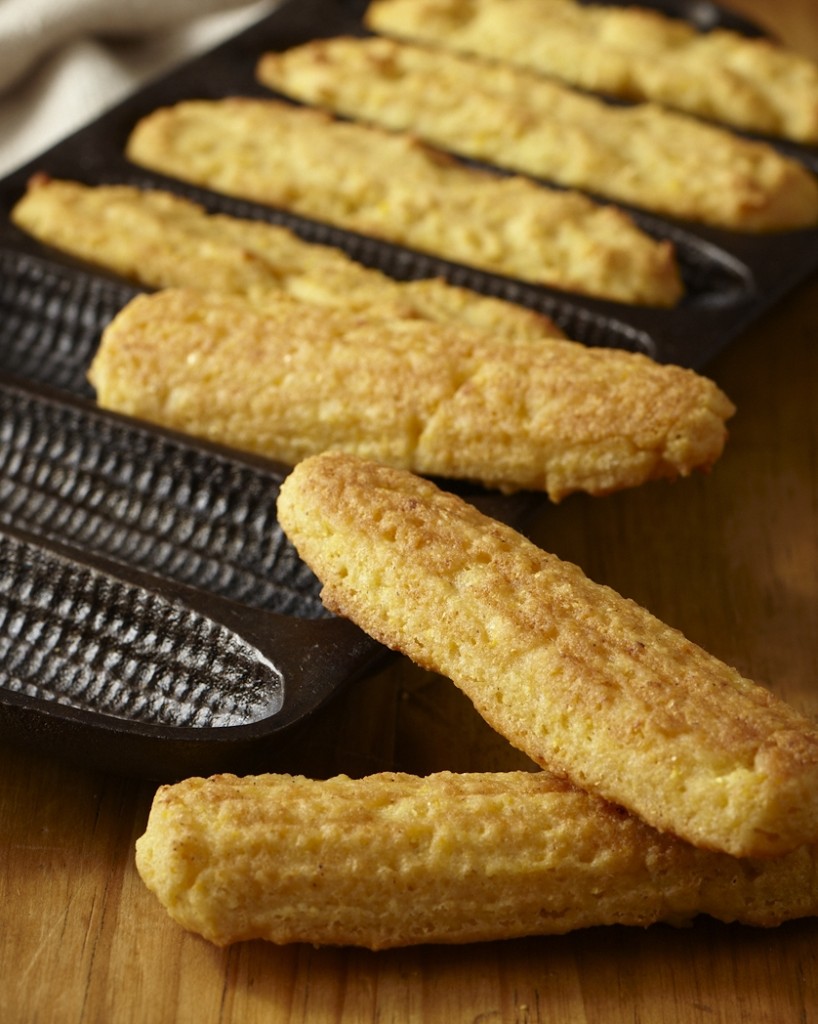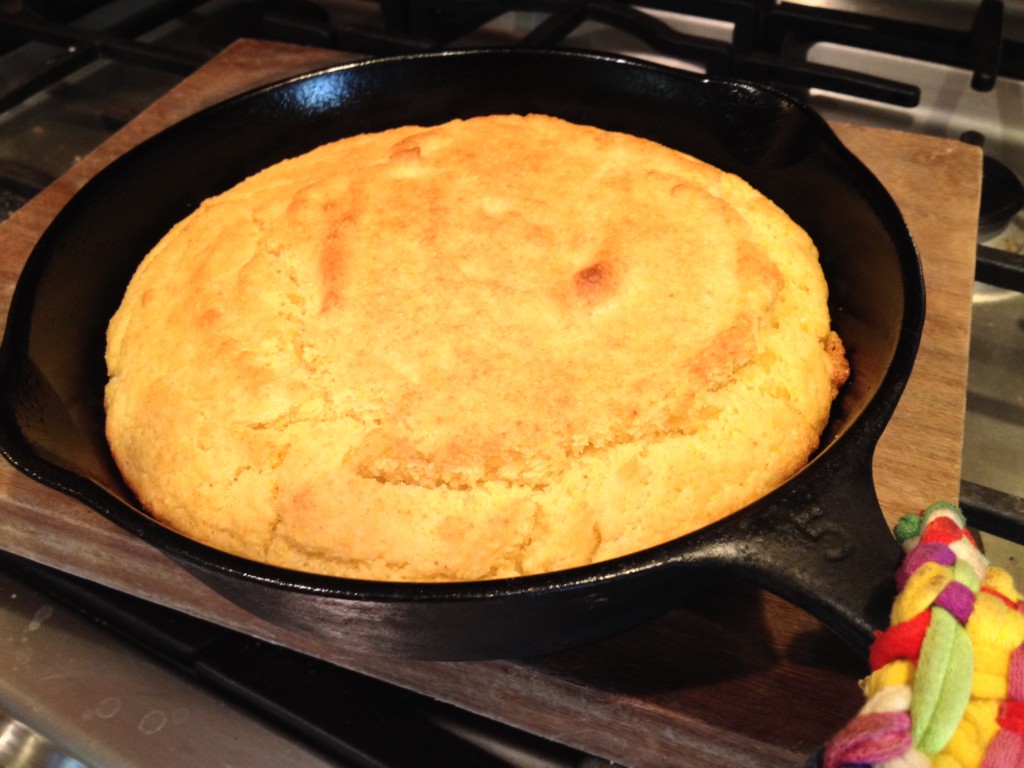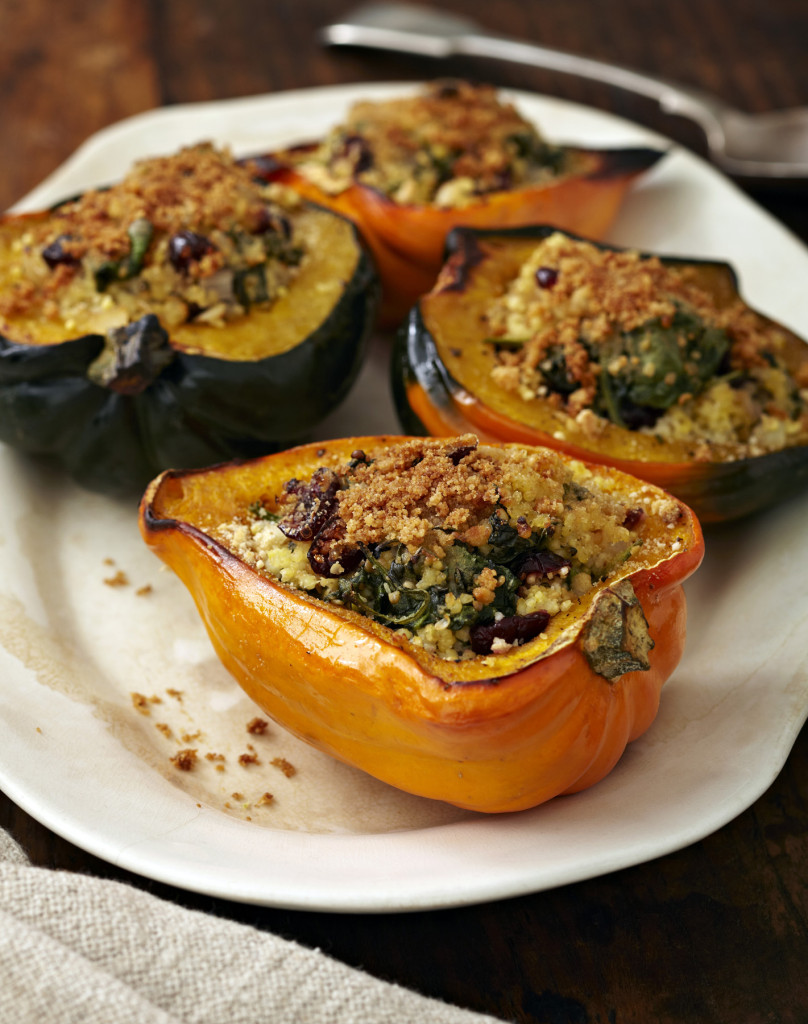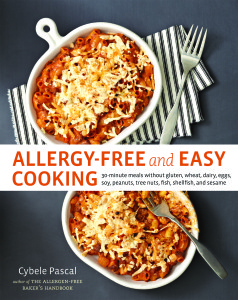Allergy Free Cornbread
As promised, here is my new and improved Allergy-Free Cornbread recipe. Serve on its own, or use it for my Allergy-Free Cornbread and Wild Mushroom Stuffing recipe. This Gluten-Free, Top 8 Allergen-Free, and Vegan recipe is a revision of my Cornbread Sticks recipe from The Allergen-Free Baker’s Handbook. I’ve altered it to be made with more readily available ingredients: Canola Oil in place of Spectrum Organic Palm Shortening, and King Arthur Gluten-Free Multi-Purpose Flour can be used instead of my Basic Gluten-Free Flour Mix or Authentic Foods GF Classical Blend. For this recipe, you can use either an 8-inch cast iron skillet (see below), or 2 cornstick pans, or an 8 x 8-inch square pan.
Allergy-Free Cornbread
1 cup rice milk
1 tablespoon freshly squeezed lemon juice
1 cup yellow cornmeal
1 cup King Arthur GF Multi-Purpose Flour, or my Basic Gluten-Free Flour Mix or Authentic Foods GF Classical Blend (this will make for BEST texture but any are fine!)
1/4 cup granulated sugar
1/2 teaspoon xanthan gum
1 tablespoon double-acting baking powder
1 teaspoon salt
1 1/2 teaspoons Ener-G egg replacer mixed with 2 tablespoons rice milk
1/3 cup canola oil
1. Preheat oven to 425°F. Preheat pan.
2. Combine rice milk with lemon juice. Set aside.
3. Whisk together cornmeal, flour mix, sugar, xanthan gum, baking powder, and salt in a large bowl.
4. Add the rice milk to the mixture and stir to combine. Add the egg replacer and the canola oil, and stir a few times until smooth. Remove the heated pan(s) from the oven, and grease liberally with baking spray or oil. Fill pan with batter, smooth surface, and bake about 25 minutes, until golden.
Allergy-Free Cornbread Copyright © 2013 by Cybele Pascal. Cornsticks photo credit: Chugrad McAndrews.
Allergy Friendly Thanksgiving Tips
 Delicious, Allergen-Free Turkey Day
Delicious, Allergen-Free Turkey Day
On Thanksgiving, we gather and we eat for upwards of four hours, all the way from pre-dinner snacks to post-dessert dessert. But a traditional Thanksgiving dinner is literally one of the most allergen-laden meals possible.Whether this is your first allergen-free Thanksgiving or your twentieth, the following tips will help make it festive, mouthwateringly delicious, and safe.
Talking Turkey:
Did you know that many fresh and frozen turkeys contain hidden allergens? Most conventional, “self-basted” turkeys have been injected with butter, water and salt, and may also contain gluten. If you’re going to go the conventional turkey route, always verify ingredients with the manufacturer before purchasing. A safer option is a “Natural” turkey, which hasn’t been treated with any artificial colors or flavor enhancing ingredients. Look for “Organic” natural turkeys at websites like Local Harvest, or stores like Whole Foods.
Another good option: natural “Kosher” turkey. Guaranteed to have no dairy injected, the benefit of a Kosher turkey is that it has already been salted, and thus doesn’t need brining. I recommend Empire, the taste test winner selected by Cook’s Illustrated Magazine. Empire turkeys are also gluten-free. If you’re a die-hard foodie, take the adventurous (albeit, most expensive) route and look for a “Heritage” turkey, which is one of the pre-World War II breeds of turkey, like Narragansett and Bourbon Red. Slow Food has a great listing of independent farmers raising Heritage turkeys, state by state. Looking for something similar to what our forefathers might have eaten? Save yourself the hunt, check out D’Artagnan, to purchase a wild bird.
Last, to keep your turkey allergen-free, baste with olive oil. There is no need for butter, and in fact I prefer turkey with olive oil.
Savory Side Dishes:
Make baked sweet potato and potato dishes using canola oil instead of butter, and orange juice or rice milk instead of milk or cream. I prefer yams/sweet potatoes without marshmallows, but if like them, look for Allerenergy marshmallows, or try vegan brands like VeganSweets, made without eggs or gelatin, but be forewarned that they contain the allergen SOY. Instead of plain rice, mix and match with old world gluten-free grains like quinoa, millet, brown rice, wild rice, and buckwheat. All of these combine well with legumes like lentils or chickpeas, and are wonderful when enhanced with fresh herbs like thyme and sage. Dip into the plentiful array of winter squash available this time of year–not just butternut and acorn, but delicata, red kuri, and sweet dumplings. For an allergy-friendly stuffing, check out my Cornbread Wild Mushroom Stuffing Recipe.
Gravy can be made with olive oil instead of butter, and alternate flours, such as brown rice flour for thickening, instead of traditional wheat flour. See my recipe for Allergy-Friendly Gravy below.
Try making roast brussel sprouts this year instead of drenching them in butter or hollandaise sauce. To roast, cook at 450 degrees on a baking tray, tossed in olive oil and sprinkled with kosher salt and pepper, for 25 minutes, shaking once or twice until a crispy golden brown on the outside, and tender on the inside.
For cranberry sauce, omit walnuts (tree nuts), and use thinly sliced tangerines or mandarin oranges, keeping the rind on, to add texture and color.
For Pie, check out my cookbook, The Allergen-Free Baker’s Handbook for any number of wonderful allergen-free pie, crumble, and crisp recipes, from Pumpkin Pie, to Apple Cranberry Pie. Or see my Allergy-Friendly Sweet Potato Pie recipe, or Cranberry Apple Crisp.
Remember: if you’re only doing a few allergen-free dishes rather than a whole allergy-friendly meal, be aware of cross contamination and cross contact while cooking and serving. Consider labeling dishes with ingredient cards. If the meal is going to be served buffet-style, serve the food allergic person first to avoid cross contamination.
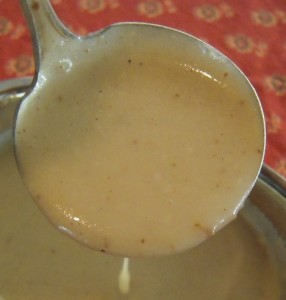 Allergy-Friendly (Gluten-Free) Creamy Gravy
Allergy-Friendly (Gluten-Free) Creamy Gravy
Makes 1 1/4 cups
Gravy is one of those things that everybody loves. Even the thought of gravy can make you smile. In fact, the term gravy, in slang, means happiness, stable goodness, and a state of complacency.Gravy also means cool, okay, and all good, as in “It’s all gravy, baby”. If something is better than gravy, it’s gravy on eggos or gravy on rice. Who doesn’t want some of that coolness poured onto their plate?
But beloved gravy is also highly allergenic. Yup, it’s loaded with no-nos for those with food allergies. Butter (dairy), wheat (gluten), and cream/milk (dairy again). It’s also often chock-full of soy derivatives.So I took on the challenge to convert beloved gravy into something allergy-friendly. Just pour this yummy goodness over rice, potatoes, turkey breast, or do like me, and eat it with a spoon!
Ingredients:
1/4 cup canola oil
1/4 cup fine brown rice flour
1/8 teaspoon onion powder
pinch of dried thyme
pinch of cayenne pepper
salt and freshly ground pepper
1 cup warm beef (or chicken or turkey) broth or stock (Kitchen Basics is allergy-friendly)
1/2 cup warm rice milk
1. Heat canola oil in heavy pot over medium-high heat.
2. Add brown rice flour, 1 tablespoon at a time, and cook, stirring constantly with a wooden spoon, 2 minutes, until golden and aromatic.
3. Add onion powder, pinch of thyme, pinch of cayenne pepper, pinch of salt, and a couple turns of freshly ground pepper. Cook about 1 minute more, stirring.
4. Reduce heat to medium. Using a whisk, whisk in the warm beef broth, in three batches. Whisk vigorously, to smooth out any lumps. Add warm rice milk, whisking, and bring to a simmer. Cook stirring often, until thick and creamy. Adjust salt and pepper to taste. Serve warm.
Allergy-Friendly, Gluten-Free Creamy Gravy
© 2010 by Cybele Pascal
(Please note that all my recipes are completely free of all top allergens (wheat, dairy, soy, eggs, peanuts, tree nuts, sesame, fish, shellfish, and gluten), so as many people as possible can enjoy them. Additionally, all the ingredients are available at Whole Foods, and online at Amazon.com. If you have trouble finding something, let me know and I’ll help you find it.)
SAFETY NOTE: Because each person’s food sensitivity and reaction is unique, ranging from mild intolerance to life-threatening and severe food allergies, it is up to the consumer to monitor ingredients and manufacturing conditions. If manufacturing conditions, potential cross contact between foods, and ingredient derivatives pose a risk for you, please re-read all food labels and call the manufacturer to confirm potential allergen concerns beforeconsumption. Ingredients and manufacturing practices can change overnight and without warning.
Stuffed Acorn Squash with Millet, Spinach, Cranberries, and Hemp Seeds
Stuffed Acorn Squash with Millet, Spinach, Cranberries, and Hemp Seeds
serves 4
Who says millet is just for the birds? Not anymore, it’s not! This old-world gluten-free grain is high protein and delicately flavored. It’s the perfect stand-in for couscous if you cook it right. Read on for the most delicious stuffed squash, packed full of nutrients galore. And so easy! I was shocked by how much my kids loved this, and I will be making it in heavy rotation now.
1/2 cup millet
11/2 cups water
2 small acorn squash, halved and seeded
Salt and freshly ground pepper
1 tablespoon olive oil
1/2 cup chopped sweet or yellow onion
2 large cloves garlic, minced or pressed
1/4 cup dried cranberries
1 (5- to 6-ounce) bag baby spinach
1 tablespoon cider vinegar
1 teaspoon sugar
1/4 cup shelled hemp seeds, toasted (see note)
4 heaping teaspoons fine gluten-free breadcrumbs (I like Ener-G for this)
4 heaping teaspoons Earth Balance soy-free buttery spread or olive oil
1. Combine the millet and water in a small pot over medium-high heat. Bring to a boil, reduce the heat to medium-low, and simmer, covered, for 18 minutes, until the water is absorbed. Don’t stir the millet or it will become creamy. You want it to cook up like rice, and refraining from stirring will accomplish this.
2. Meanwhile, spray the insides of the acorn squash halves with cooking spray or brush lightly with olive oil. Sprinkle with salt and pepper. Place face down on a large microwave-safe dish (I just use the microwave tray). Cover (I use a large mixing bowl—it’s okay if the squash halves have to overlap a bit) and cook for 16 minutes, or until the squash is tender.
3. Meanwhile, heat the olive oil in a large heavy pan over medium heat. Add the onion and cook for 2 minutes, until tender. Add the garlic and cranberries and cook, stirring, for 1 minute. Add the spinach and cook, stirring often, until wilted, 2 minutes. Add the vinegar and sugar, stir, and season with salt and pepper. Cook, stirring, for 1 minute. Remove from the heat and stir in the hemp seeds.
4. While the millet is cooking, preheat the broiler on high.
5. Once the millet is cooked, fluff it lightly with a fork. Combine 1 cup of the millet with the spinach mixture and toss. Put the squash halves cut side up in a broiler-safe pan or on a rimmed baking tray. Divide the filling evenly among the squash halves, mounding it slightly. Top each squash half with 
1 heaping teaspoon breadcrumbs and dot each with 1 heaping teaspoon buttery spread. Broil 
8 inches from the heat source for 4 to 5 minutes, until browned.
* Note: To toast hemp seeds, heat a small frying pan or 
skillet over medium heat. Add the hemp seeds and 
cook, stirring often, for 2 to 3 minutes, until golden 
and aromatic.
“Reprinted with permission from Allergy-Free and Easy Cooking: 30-Minute Meals Without Gluten, Wheat, Dairy, Eggs, Soy, Peanuts, Tree Nuts, Fish, Shellfish, and Sesame by Cybele Pascal (Ten Speed Press, © 2012). Photo credit: Chugrad McAndrews.”
